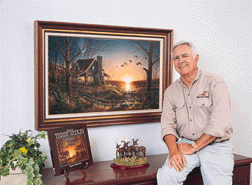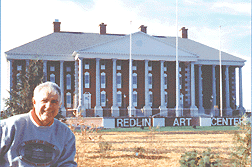-trans.gif) |
 |
-trans.gif) |
 |
From Midwest Today, December 1999
TERRY REDLIN: AMERICA'S
MOST POPULAR ARTIST
The South Dakota native
turned an accident into a career
By Larry Jordan
As Midwest painter Terry Redlin
has proven, art truly is in the eye of the beholder. Despite the
fact that his works idealize a nostalgic vision of rural America
which some critics see as hopelessly passe, he is without question
the most popular artist in the country today. A native of South
Dakota, Redlin maintains a prodigious output of new works, each
of which seems to be received with the same enthusiasm as the
one before it. Having expanded his subject matter from wildlife
to Americana themes, he is one of the few artists who has been
successful in broadening his appeal from mere hook and bullet
art collectors to the mainstream market.
Over a career that spans two and a half decades, Terry Redlin
has sold millions of paintings -- often to people who don't ordinarily
buy art -- and earned a place in living rooms and boardrooms alike.
Redlin grew up in a more innocent age, in the small community
of Watertown, South Dakota. Always in love with the outdoors,
he hunted and fished, and pursued an active lifestyle as a youngster.
But a motorcycle accident when he was 15 years of age cost him
part of a leg -- and ended his dream of becoming a forest ranger.
His disability is a fact he kept from the public for years because
he wanted his work judged on its merits, without being thought
of as a "handicapped artist."
Yet in a way, the accident was providential. "I definitely
wouldn't have been an artist otherwise," he reflected in
an exceedingly rare -- and exclusive -- interview with Midwest
Today. "I looked around at that point and I took quick
stock of everything. I knew painting was the one thing I could
do where I could sit down..."
Redlin earned a degree from the St. Paul School of Associated
Arts, thanks largely to his wife, Helene, who worked full-time
to put him through school.
After graduation, he went to work for Brown and Bigelow, an art
firm with a morgue that contained "so many of the originals
by those like Rockwell that I love, John Klimer and a lot of what
I call the 'old masters' of the 1930s and '40s -- and all
the various styles like Linedecker on."
Redlin says he learned about technique by studying these works
close up: "Every noon hour, I'd take my brown lunch bag and
go in there and sit and just kind of look around and observe all
this great art."
Later, Redlin became an art director for the Webb Company of Minneapolis,
where he learned the printing business.
By the mid-1970s, Terry decided to expand his hobby of painting
into a full-time avocation. His first piece, "Winter Snows,"
was an open edition priced at $10.
"When I started, I did everything to cover myself, so there
was no luck involved," he laughs. "I figured if I couldn't
make it all on prints, I would compete with framing, shipping
-- I did everything."
Redlin's work was so well received, he forsook the security of
a weekly paycheck and started to paint full-time on his own.
The secret is in the lighting
A trademark of the Redlin style is that his paintings tend to
be rather dark, with warm hues -- scenes at night, at dawn or
dusk -- when shadows are longest.
"Everything, to be lit, has direct light but it also has
reflective light," Redlin explains. "That's kind of
a basic thing that artists have to start learning how to observe
-- what happens with reflective light coming back from an object,
glancing off of it. You can do a lot of things if you have that
concept in your head."
Terry Redlin captures the fleeting moments, the beauty we've all
observed in the Midwest at the beginning or end of a day, when
the hills, woodlands, lakes, prairies and wildlife are at their
poetic best. Looking at his lyrical paintings, you can imagine
waves gently lapping at the shores of a lake, the honking of geese
as they fly in a great "V" across the sky, the sunset
a particular apricot color, the snow as it sifts from pine branches,
or the silvery moon on a crisp night. His work is the equivalent
of "comfort food" -- in this case, comfort art -- and
it imbues us with a sense of well-being.
Like Pyle and Wyeth, Redlin sees the advantages of living away
from the urban center. So he lives on the western shores of Lake
Minnetonka, in the middle of an old duck pass. Though his studio
is flanked by broad windows, he has a bank of fluorescent "daylight"
bulbs over his work area. He avoids natural lighting because,
he says, it tends to be too variable for "a lot of subtleties
in my paintings."
Terry labors assiduously at his craft, perfecting his technical
skills much as a concert pianist returns to the scales even after
mastering the most complex compositions. He works both from direct
observation and from his imagination, and is painstaking in his
concern for details. "Even when I was real young, I could
take a look at anything and draw it exactly," he recalls.
"The painting that I do today is the result of a very long
learning process. The ability to be able to sketch anything from
sight without any distortion -- I can get it exactly, with no
problem. It just comes."
Redlin confides that "all my paintings these days are 97%
memory, and just a couple of percent for technical." He has
a bank of 10,000 slides plus over 100 stuffed animals in his home
-- from teal to bobcats and a scowling badger.
But, he says, "When you work from memory, you get a different
look that is all your own. That's what makes art interesting and
great. I'm not knocking photo realism but to just copy a scene
from a photograph is not what I find challenging or a proper way
of measuring my ability.
"I will inject things that aren't really there, or take away
things. People say, 'gee, that looks like a photograph.' But it's
not even close. It's such a romantic vision."
Redlin refers to the Golden Age of Illustration -- that period
at the end of the 19th century and the early decades of the 20th
-- when books and periodicals were a major source of public entertainment.
The best literature of the day was interpreted in pictures by
the best artists. Redlin's heroes are Frederic Remington, Maxfield
Parrish, Charles Dana Gibson and Howard Chandler Christy - -men
who shaped the cultural appetites of their era.
Many preferred recognition as artists, not illustrators, and the
schism between fine art and commercial illustration has widened
over the years as prejudices have magnified.
Redlin doesn't mind being called an illustrator. "Illustrating
involves some of the technical aspects of being able to do the
job properly," Redlin believes. "The inspiration and
ideas is the art part as well, but it marries together. Rembrandt
and the like were illustrators, too -- they illustrated for the
church."
Terry Redlin admits he has "fun pleasing the public. That's
the joy part to me. Anybody that says they're just painting for
themselves, I think they've got a little growing up to do."
Not surprisingly, Redlin says his idol was Norman Rockwell. Paintings
by both men derive from the same wellspring of optimism.
But there are notable differences: Redlin paints wildlife and
landscapes, Rockwell painted people. Redlin relies on the appeal
of the natural environment, whereas Norman Rockwell was endlessly
fascinated by human nature.
Each morning, Redlin gets up between 5 and 6 a.m., then paints
until 3. Afterwards, he often goes out on his boat. "I cruise
around the bays and inlets getting ideas -- the skies, you know,
just observing."
As for technique, Redlin acknowledges that "I've always worked
with just oil after I went on my own. When I was a commercial
illustrator, I worked with acrylics for speed. You could have
a painting in the mail at night. But when I was in art school,
I always loved the smell and flavor of oil, and I've just kind
of migrated back to it because I'm not in any hurry."
Redlin puts four colors on his palette -- a hand-mixed blue, and
tubes of red, yellow and white. "You need nothing more than
that," he says. "It's no different than the guy who
enters the bait and tackle store and sees these vast numbers of
different fishing lures hanging on the wall. In actuality, he
only needs a half-dozen lures to catch 95% of the fish."
Terry begins a painting by priming his work surface, and when
it dries, making a very loose sketch, drawing in the horizon line
and a few other guidelines with a brush. "I use a traditional
technique -- roughing in the whole area with big brushes to establish
a mood before including any unique details. This usually entails
putting the sky in first and roughing the ground work or snow
in. Then on top of that, I start working back and forth all across
the way to the end. When I'm into the details, I never paint on
one area very much. I feel in the end I have a better total balance."
One of his proudest achievements is the opening of the Redlin
Art Center he had built in his hometown of Watertown. The building
houses many Redlin originals. An elementary school in Sioux Falls
is named in his honor. A new book, "Master of Memories,"
features 57 of his most recent paintings plus an extensive biography
tracing his life and career. Redlin has also appeared on the qvc
shopping network and donated $34 million to charity.

Back to the top
Copyright 11999. All rights reserved.